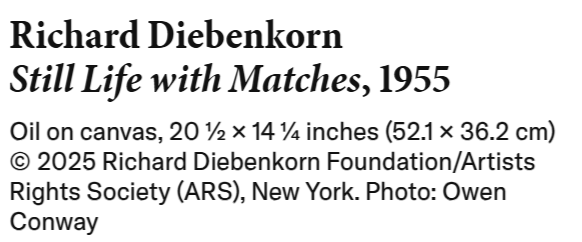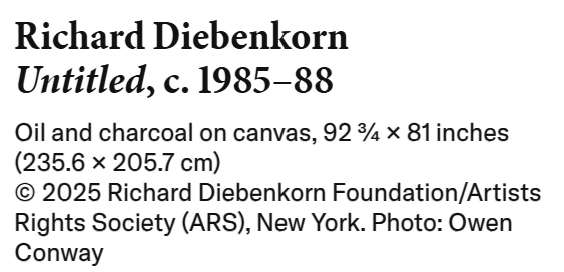

Richard Clifford Diebenkorn Jr. was born in April 1922 in Portland, Oregon. When he was just two, his father—an executive in the hotel supply business—moved the family to San Francisco, where Diebenkorn would spend much of his youth.
He attended Lowell High School from 1937 to 1940 before enrolling at Stanford University.
At Stanford, he focused on studio art and art history, studying under Victor Arnautoff and Daniel Mendelowitz. Mendelowitz, recognizing his student’s talent, nurtured his growing interest in American modernists such as Arthur Dove, Charles Sheeler, and Edward Hopper.
He also introduced Diebenkorn to the remarkable art collection of Sarah Stein, Gertrude Stein’s sister-in-law.
There, Diebenkorn encountered works by Paul Cézanne, Pablo Picasso, and Henri Matisse—an early immersion in European modernism that would leave a lasting imprint on his artistic development.
In June 1943, he married fellow Stanford student Phyllis Gilman.
The couple later welcomed two children: Gretchen in 1945 and Christopher in 1947.

From 1943 to 1945, Diebenkorn served in the U.S. Marine Corps. While stationed in Quantico, Virginia, he sought out significant modern art collections, visiting the Museum of Modern Art in New York, the Gallatin Collection at the Philadelphia Museum of Art, and the Phillips Collection in Washington, D.C.
These encounters deepened his engagement with the work of Cézanne, Julio González, Paul Klee, Joan Miró, Mark Rothko, and Kurt Schwitters.
He was particularly captivated by Matisse’s Studio, Quai St. Michel (1916) at the Phillips Collection—a painting that resonated strongly with him.
During his military service, he continued to draw representational sketches, producing what is often referred to as his “wartime” work while stationed in Southern California and later in Hawaii.
Gagosian is set to unveil a sweeping and deeply resonant exhibition devoted to Richard Diebenkorn, opening November 8, 2025, at the gallery’s storied 980 Madison Avenue location in New York.
Curated by Jasper Sharp and organized in partnership with the Richard Diebenkorn Foundation, the exhibition marks an important milestone: the formal beginning of Gagosian’s representation of the artist, and the poignant return of Diebenkorn’s work to the very site where his final exhibition of paintings was mounted from late 1992 to early 1993.
The moment feels almost circular—an artist of immense sensitivity and steadfast vision coming back, more than three decades later, to a space that once held the closing chapter of his life’s painterly quest.
Diebenkorn—who spent nearly the entirety of his career in California—built an artistic vocabulary that resisted the expectations of his time.
While many artists chose one visual language and followed it unwaveringly, Diebenkorn moved through abstraction, figuration, and back again with a confidence that felt almost musical.


His early Abstract Expressionist canvases, charged with gesture and immediacy, gave way in the mid-1950s to works rooted in observation—quiet interiors, luminous figure studies, and landscapes saturated with atmosphere.
Then, in the late 1960s, he shifted once more, opening the vast and luminous chapter of the Ocean Park paintings, a body of work spanning two decades that fused structure, openness, and light into a singular visual architecture.
One of the most compelling aspects of Diebenkorn’s creativity was his willingness to preserve the evidence of his process.
Pentimenti, ghostly underlayers, and revisions remain visible, as if the painting itself had kept a record of its own becoming.
Diebenkorn often described his goal as achieving a picture that “sits right”—a deceptively simple phrase that belies the complexity and emotional precision embedded in his work.
The upcoming exhibition brings together six decades of paintings and works on paper, tracing the continuity that threads through his ever-evolving style.
It includes an unusually broad spectrum of material, from an early 1943 watercolor shaped by the influence of Edward Hopper and Paul Cézanne, to his bold Abstract Expressionist compositions from the 1950s, to a rarely shown monumental nude from 1960 that pays homage to Matisse while foreshadowing the sweeping scale of the Ocean Park series.


These major works are joined by selections from Diebenkorn’s last decade—an era in which he approached paper with renewed intensity.
These later pieces often reveal the artist at his most distilled: compositions where a single stroke, a subtle scrape, or the friction between line and plane becomes the heart of the work.
Works on paper form a significant core of the exhibition, illuminating the intimacy and experimental boldness that defined this parallel track of Diebenkorn’s practice.
Whether using ink, charcoal, graphite, gouache, collage, oil, or acrylic, he treated paper not as a mere support but as a dynamic field for thinking.
His drawings reveal a searching mind—direct, exploratory, and open to surprise.
Among them is a 1975 ink and gouache drawing from the Ocean Park years, its architecture defined by clean planes and measured gestures; a luminous mixed-media work from around 1988 composed on joined poster board, glowing with layered color; and a near-minimal gouache from 1988–91 that elevates the modest rectangular stroke of a flat brush into a study of rhythm and restraint.
Equally moving is a late, vertically oriented piece in which charcoal lines—suggestive of foliage, memory, or drifting shadows—hover over a subtly altered grid, offering a quiet meditation on order and intuition.
John Elderfield, one of Diebenkorn’s foremost scholars, famously described the artist’s “thinking in drawing”—the belief that the act of drawing itself allowed him to navigate toward intention. Elderfield, who began visiting Diebenkorn in the mid-1980s and later curated MoMA’s seminal exhibition The Drawings of Richard Diebenkorn (1988–89), saw in these works the evidence of a mind that expressed itself most authentically through mark-making.
Sharp expands this idea in the context of the current exhibition: “What becomes clear is Diebenkorn’s extraordinary fluency—how naturally he shifted between media, scale, and atmosphere. The works communicate with one another across time, forming a subtle echo chamber of recurring shapes, moods, and spatial negotiations. In this continuity you feel the humanity of his practice: rigorous, inquisitive, and quietly radical.”
In bringing together such a wide arc of material, Gagosian not only honors the depth of Diebenkorn’s legacy but also creates space for new interpretations.
Viewers will have the rare opportunity to perceive the connective fibers that link his wartime watercolors to the vast geometry of Ocean Park, or to trace the gentle tremor of a charcoal line back to the early days of his search for clarity and structure.
The exhibition stands as both tribute and reintroduction. It reaffirms Diebenkorn as a pivotal figure who sustained a dialogue with artists across centuries—from Hopper to Matisse, from Cézanne to his own contemporaries—while also forging a language unmistakably his own.


His ability to distill emotion into structure, and structure into something deeply felt, continues to inspire new generations of artists who look to his work for its honesty, openness, and quiet courage.
By returning to 980 Madison Avenue, Richard Diebenkorn’s art once again occupies a space charged with history and memory. And in doing so, it offers a renewed opportunity to experience the depth, complexity, and gentle intensity of an artist who transformed the act of looking into an act of reflection.